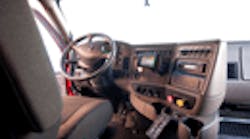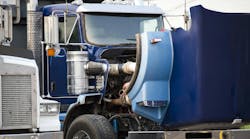A new driver recruiting and retention battleground is taking shape as turnover rates keep rising and an acute shortage of personnel continues to be predicted for the future: truck cab interiors.
As a result, cab interiors – from dashboard layouts to seating systems and beyond – are becoming a much more critical factor not only in maintaining an adequate supply of drivers, but also in terms of maintaining, if not increasing, truck sales market share as well.
“What will be the differentiator among fleets and truck brands in the future? It will be the ‘health, wellness, and well-being’ attributes of the truck interior as it relates to the driver,” explained Sandeep Kar, global director-commercial vehicle research for global consulting firm Frost & Sullivan, at a recent industry convention.
“The truck cab is both the work space and living space for drivers, so it has to offer a better ‘mind-body’ solution for both an aging workforce in need of improved ergonomics as well as offering amenities that appeal to a new, younger generation of potential drivers,” he noted.
(Video: Sandeep Kar discusses how cab interiors influence driver retention)
Kar added that, from the OEM perspective, the cab interior is also one of the last areas that can truly create “differentiation” between makes and models of trucks, helping fleets attract and keep a wide range of drivers in the seats of their vehicles.
For example, Gary Blood, product manager for Cat trucks, told Fleet Owner that “driver attraction and retention” was a critical metric used in the design of Caterpillar’s new CT660 vocational truck – especially in terms of the vehicle’s cab interior.
“Our starting point was driver ergonomics with this truck,” he explained during a special ride and drive event Caterpillar held at its Edwards Demonstration & Learning Center this week. “As a result, we’re offering three different seating systems for fleets to choose from for their drivers, along with what we call an ‘optimized dashboard’ so drivers can more easily scan gauges and reach rocker switches.”
Particular focus got paid to small interior details, such as eliminating potential “BSR” – short for “buzz, squeak, and rattle” – items as well as moving to round air vents, said Blood, as round vents were found to increase air flow into the cab versus square and rectangular-shaped ones.
While such particulars may seem minor to fleets in some quarters, the issue of driver retention is not – especially as driver turnover rates are starting to climb.
According to the American Trucking Assns.’ (ATA) latest Trucking Activity Report, the turnover rate for over-the-road truck drivers rose to 79% in the second quarter – marking the third quarter in a row of increased churn in the driver market, the trade group said.
The driver turnover rate at large truckload fleets increased four basis points from the first quarter’s rate of 75%, pushing the rate to its highest point since the second quarter of 2008, while small TL and LTL fleets actually witnessed a decline in turnover, with rates dropping to 47% from 50% for small TL firms and to 6% from 8% for LTLs.
“Even though the increase [in turnover] was small [for large TL carriers] , we still believe the market for quality drivers is getting extremely tight and fleets are aggressively recruiting to fill their openings,” Bob Costello, ATA’s chief economist, pointed out.
“The slowdown of the economic recovery has affected the turnover rate, but if the economy continues to improve we’ll see further tightening in the driver market and a renewed risk of a severe driver shortage,” he said.
Noel Perry, senior consultant with FTR and principal of consulting firm Transport Fundamentals, added during a webinar last June that this is just the tip of the iceberg in terms of how scarce truck drivers may become in the not-so-distant future.
For starters, revisions to hours of service (HOS) regulations should hit trucking in 2012 – at the same time new rules regarding driver health and wellness, identification, electronic onboard recorders (EOBRs), to name just a few also will go into effect. “We believe all of that translates into a shortage of about 400,000 drivers,” Perry warned.



